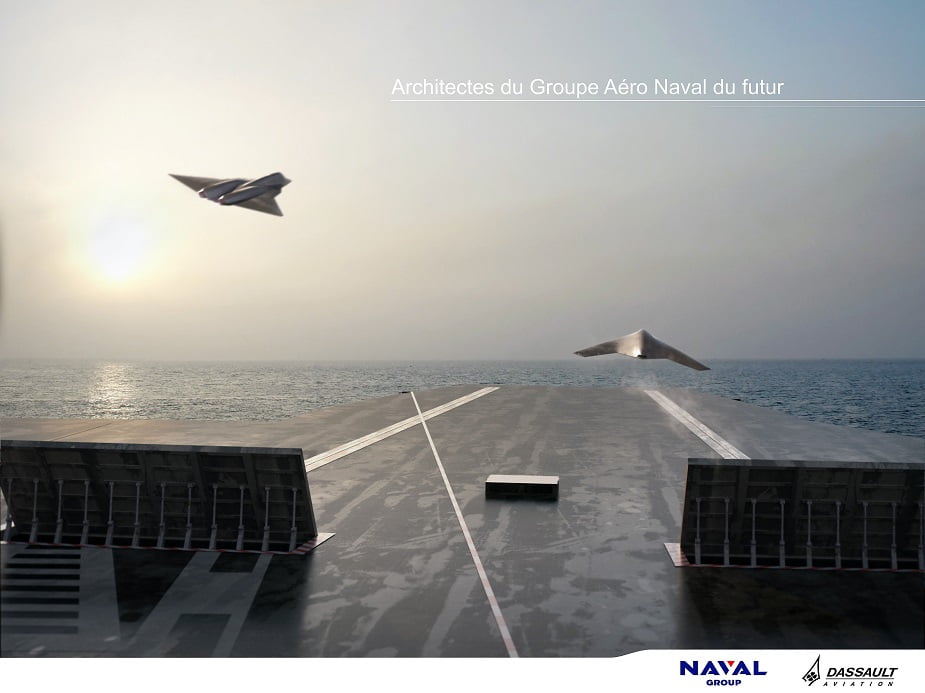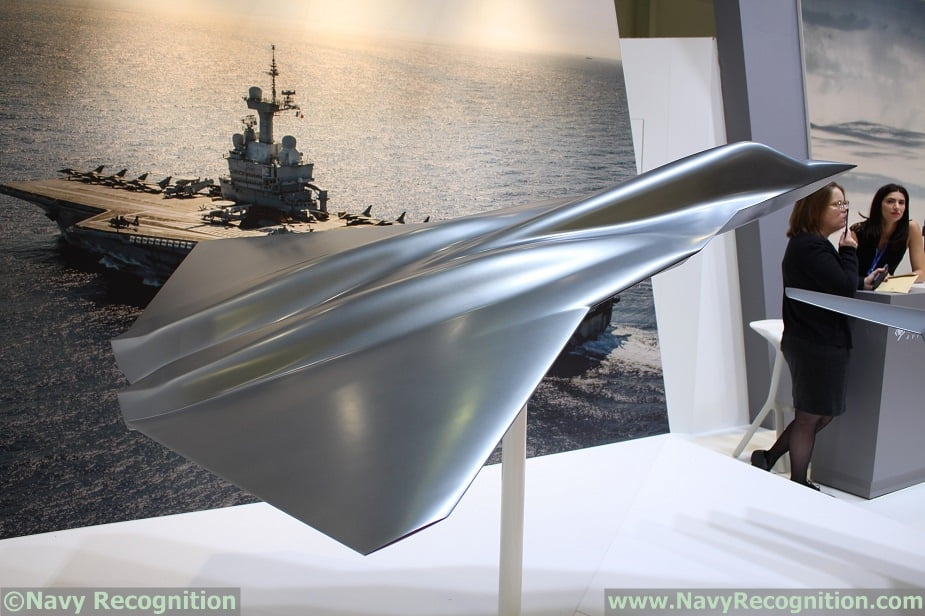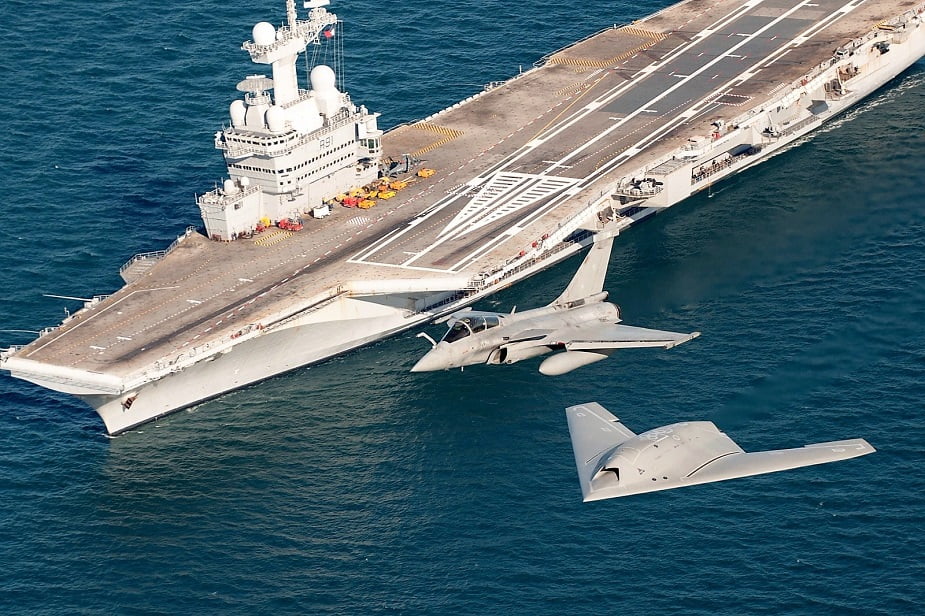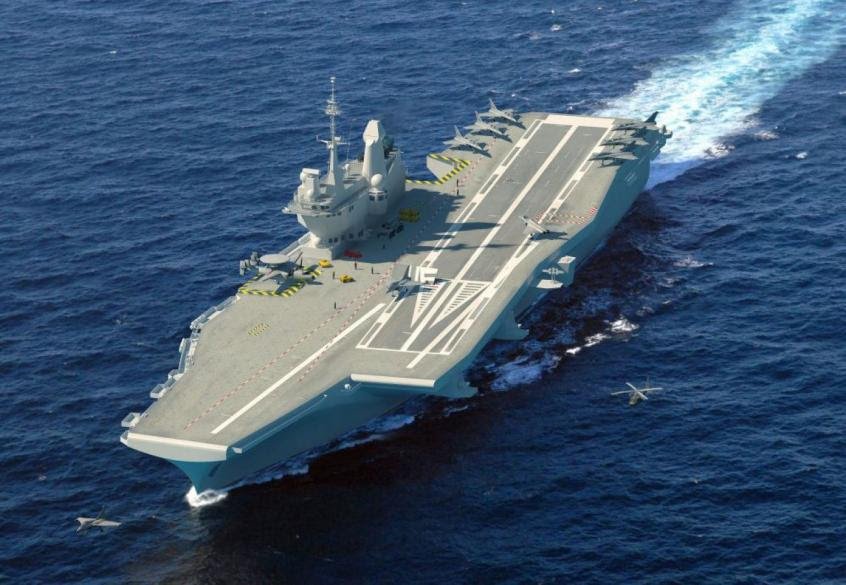Adding a new seabase to the mix for the defense of Europe and its interests is what the current Macron government is considering.
With the opening of a study phase for a new carrier, the French Defense Minister announced at the recent Euronaval show that France was pursuing a path for adding a new generation carrier.
At Euronaval 2018, Florence Parly, the French Defense Minister, had this to say about the launch of a study to assess the possibility of a new French aircraft carrier.
[…] We must also prepare, resolutely, for the future of our carrier group. It is a strategic capability of our national defense and our Marine Nationale. An efficient and effective capacity. An ability that we must maintain and renew.
Today, the Charles de Gaulle finishes up its mid-life upgrade. From the first quarter of 2019, it will be able to sail on an operational mission with it entire air wing. I wanted to salute here all the state and industrial actors who took part in this exceptional project, one of the most important conducted in recent years in our country. Thanks to the work of all, the Charles de Gaulle still has a great future ahead of it, well beyond 2030.
But, the Charles de Gaulle will need a successor. In a world where only “the immediate” counts, it was perhaps more comfortable to postpone this choice until later. It’s not really my understanding of the role of policy makers. That’s why I’m proud today, here at Le Bourget, at this Euronaval show, to officially launch the renewal program for our aircraft carrier.
This stage one, which is launched today, is the study phase. It’s about determining together what we want and how we want it for our future aircraft carrier.
We give ourselves 18 months. 18 months to answer three questions:
The first: what threats will it face?
What missions for this future aircraft carrier?
From these answers, we will be able to deduce the employment constraints, the needs in terms of combat systems and the necessary articulation with his escort.
The second issue that we will discuss is the characteristics of our future aircraft carrier based on which state of the art technologies will be available in 2030. We launched in cooperation with Germany, the future combat aircraft system, FCAS.
The aircraft carrier will have to be able to accommodate it in all its capacities. The mode of propulsion, nuclear or conventional, will be examined. We will have to take into account, too, the future technological breakthroughs. I think, for example, of the revolution represented by electromagnetic catapults.
In answering this question, we will always have to keep an eye on the cooperation we could carry out. Cooperation for the ship itself, perhaps, but also cooperation to allow the new generation aircraft carrier to accommodate aircraft from our European partners. This aircraft carrier could serve until the last decades of the 21st century, we can not afford to design it with a narrow horizon.
The last question we will answer is that of innovation. We must not limit our horizon or our imagination. We should not repeat identically what we already have, but seek the most ingenious, useful and effective capabilities. Let’s make this aircraft carrier a true advanced base of our navy and the spear tip of our innovation.
We will have to be realistic but ambitious. And thanks to these in-depth, imaginative and rigorous studies, we will be able to establish the architecture of this future aircraft carrier and lay the foundations for the industrial organization needed to build it on time and at cost.
Through these studies, we will be able to determine, as well, the number of units that France and Europe will eventually need. Let’s not put the cart before the horse, now is the time for design, not yet to determine how many ships are needed.
We have 18 months in front of us.
18 exciting and exhilarating months.
The studies will be completed in 2020, I will follow them with the greatest attention.
And then, we will be able to propose choices to the President of the Republic.[…]
As the US and the United Kingdom have launched three new carriers in the past few years, clearly it will be important for France to look at the innovations introduced by their allies in the carrier domain.
New aircraft, new launch systems, new C2 systems, new ISR systems, new power generation systems with a clear leaning forward to the coming of directed energy weapons is clearly part of that picture.
To what extent the French adopt US and UK technology is an open question, but clearly there is an interest in doing so and a case in point is the new EMALs system onboard the USS Ford.
During our visit onboard the USS Ford, we discussed EMALS and its impact on the carrier navy.
In a piece, which we published on January 25, 2015, we discussed the USS Gerald R. Ford’s landing and take off systems, clearly of interest to the French.
During our visit to the Gerald R. Ford, we examined both the Electro-Magnetic Aircraft Launch System (EMALS) and the Advanced Arresting Gear (AAG) and discussed them with Captain Meier and with Mr. Hicks, Construction Superintendent.
With regard to the installation of meals, the two big steam cylinders are replaced with banks of electromagnetic motors.
A great advantage of EMALS is the acceleration curve is very smooth.
It ramps up very smooth as opposed to a steam cat that spikes up on the front end.
The control that you have around that acceleration is virtually infinite.
And if you get half way down the cat and the system senses that you’re not getting there, it will increase power as necessary to reach end speed.
The system itself is intelligent enough to increase power as you go and increase the acceleration rate so that at the end you’re actually going 160 knots per hour or whatever you want to be at the end.
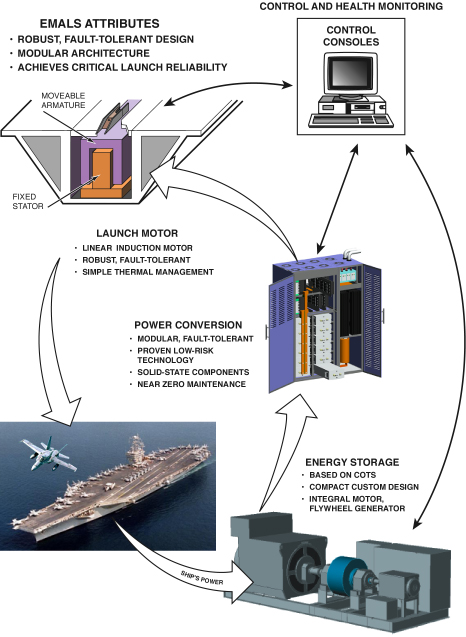
Question: Computer control must play a key role in the system?
Hicks: It does. With the steam catapult, the steam valve opens and you get what you get.
If it turns out the speed is not building up as expected, you have no other options. The system is not going to try to fix itself.
This system has tons of detectors in it that every little nuance and every step along the way is measured , it knows what the speed should be, what the speed is, what power is available and how to increase power or decrease power as necessary.
When you think about that there’s a whole array of failures that can happen within this system and still give the proper launch speed.
It’s impressive to watch the system operate at Lakehurst.
They deliver 150 knots every single time.
Question: This will allow for less loss of aircraft and provide less wear and tear on the airframes?
Hicks: It should reduce the wear and tear on the airframes…..
Question: Maintenance should be improved as you shift from hydraulics and steam?
Hicks: It clearly should and we provide a very different approach to maintenance as well associated with computer management of an electric power driven system.
There is a single officer on a single console who does the health monitoring of the system and will guide the maintenance process.
This system is one of numerous initiatives built into the design of this ship that will allow us to change from the current nine to ten year dry dock repair cycle and extend it to a 12 year docking cycle.
Essentially in a half-life you have taken away one full dry dock repair cycle.
The publication Navy Recognition highlighted the French interest in EMALS in an article by Xavier Vavasseur, the Editor in Chief of the website.
The French defence procurement agency (DGA) and the French Navy (Marine Nationale) started discussions with the United States regarding Electromagnetic Aircraft Launch System (EMALS) for the potential future French aircraft carrier. According to our information, the program will be known as “PA NG” (for porte-avions de nouvelle génération in French).
During the Euronaval 2018 press conference held on September 24, General Sellier, DGA’s head of naval programs told Navy Recognitionthat discussions on EMALS with American counterparts started in the summer of 2018.
While he stressed that those were preliminary talks and that no firm decision have been taken (about fitting EMALS on a future aircraft carrier) yet, he acknowledged that the discussions included technical aspects…..
During the Naval Group Innovation Days, back in June, Naval Group’s CEO Hervé Guillou told Navy Recognition that there are two new factors, two “unknowns” that will impact the size of a future aircraft carrier: The first one being the EMALS.
Guillou explained that technical details about the EMALS were necessary in order to design and size the aircraft carrier.
The second factor being the air-wing: More than the FCAS (the future manned combat aircraft currently being developed by France and Germany) Guillou stressed that the real unknown factor is the future UCAV because drones have never been used aboard aircraft carriers before: Future carrier vessels will have to be sized taking into account the “unmanned aircraft” factor.
The DGA and French Navy previously conducted a test campaign to study the use of a UCAV in a naval environment: In July 2016, the nEUROn unmanned combat aerial vehicle (UCAV) demonstrator made several low altitude vertical passes above aircraft carrier Charles de Gaulle.
The test campaign included interactions at sea with the aircraft carrier Charles de Gaulle to assess the nEUROn’s stealthiness relative to the naval platforms sensors.
The featured photo shows a Naval Group / Dassault Aviation image showing the NGF (next generation fighter) and a UCAS being launched from a conceptual aircraft carrier.
Note the two bow catapults (design feature never used before aboard French carriers).


